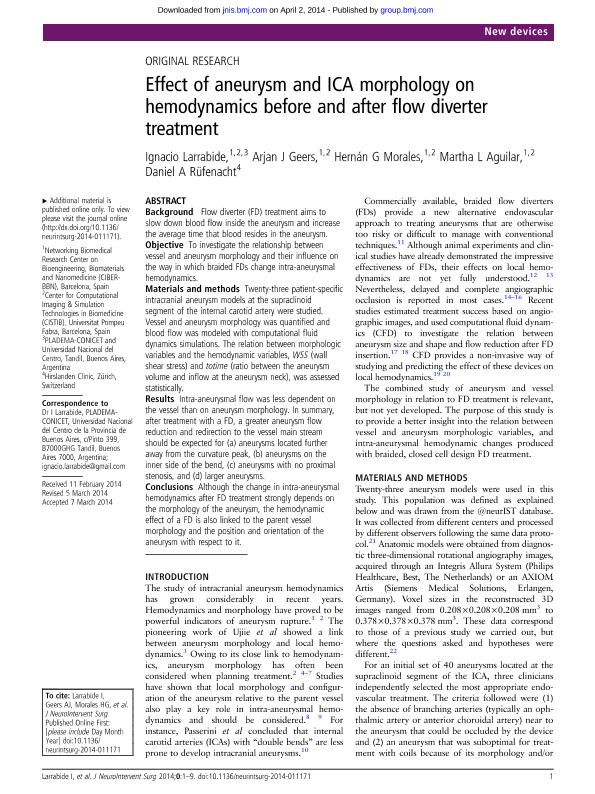Artículo
Effect of aneurysm and ICA morphology on hemodynamics before and after flow diverter treatment
Fecha de publicación:
2014
Editorial:
Society of NeuroInterventional Surgery
Revista:
Journal of NeuroInterventional Surgery
ISSN:
1759-8478
Idioma:
Inglés
Tipo de recurso:
Artículo publicado
Clasificación temática:
Resumen
Background: Flow diverter (FD) treatment aims to slow down blood flow inside the aneurysm and increase the average time that blood resides in the aneurysm. Objective: To investigate the relationship between vessel and aneurysm morphology and their influence on the way in which braided FDs change intra-aneurysmal hemodynamics. Materials and methods: Twenty-three patient-specific intracranial aneurysm models at the supraclinoid segment of the internal carotid artery were studied. Vessel and aneurysm morphology was quantified and blood flow was modeled with computational fluid dynamics simulations. The relation between morphologic variables and the hemodynamic variables, WSS (wall shear stress) and totime (ratio between the aneurysm volume and inflow at the aneurysm neck), was assessed statistically. Results: Intra-aneurysmal flow was less dependent on the vessel than on aneurysm morphology. In summary, after treatment with a FD, a greater aneurysm flow reduction and redirection to the vessel main stream should be expected for (a) aneurysms located further away from the curvature peak, (b) aneurysms on the inner side of the bend, (c) aneurysms with no proximal stenosis, and (d) larger aneurysms.
Palabras clave:
Intracranial Aneurysms
,
Computational Fluid Dynamics
,
Morphology
Archivos asociados
Licencia
Identificadores
Colecciones
Articulos(CCT - TANDIL)
Articulos de CTRO CIENTIFICO TECNOLOGICO CONICET - TANDIL
Articulos de CTRO CIENTIFICO TECNOLOGICO CONICET - TANDIL
Citación
Rufenacht, Daniel A.; Aguilar, Martha L.; Geers, Arjan J.; Larrabide, Ignacio; Morales, Hernán G.; Effect of aneurysm and ICA morphology on hemodynamics before and after flow diverter treatment; Society of NeuroInterventional Surgery; Journal of NeuroInterventional Surgery; 7; 4; 2014; 272-280
Compartir
Altmétricas




